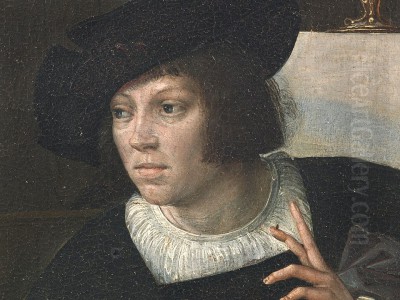
Bernaert van Orley stands as a pivotal figure in the Northern Renaissance, a versatile and prolific artist whose career unfolded primarily in the vibrant artistic center of Brussels during the first half of the 16th century. Often known as Barend van Orley, his life, generally dated from around 1488 (though some sources suggest 1487 or even 1491) to his death on January 6, 1541, coincided with a period of profound artistic transformation across Europe. He excelled not only as a painter of altarpieces and portraits but also achieved remarkable renown as a designer of tapestries and stained glass, leaving an indelible mark on the visual culture of his time. His significance lies particularly in his role as one of the leading proponents of Romanism in the Low Countries, skillfully integrating the burgeoning aesthetics of the Italian High Renaissance with the established traditions of Flemish art.
Early Life and Artistic Formation
Born into an established family of artists in Brussels, Bernaert van Orley's path into the arts seemed almost preordained. His father, Valentin van Orley (c. 1466–1532), was a painter, and records suggest Valentin originally hailed from Luxembourg before settling in Brussels. Bernaert likely received his initial training within his father's workshop, a common practice at the time. His family included other artists as well, such as his brother Philipp, who also engaged in painting and tapestry design. This familial immersion in artistic practice provided a foundational understanding of technique and the business of art production in a city renowned for its luxury crafts.
The artistic environment of Brussels at the turn of the 16th century was rich, though still deeply rooted in the Late Gothic traditions exemplified by earlier masters like Rogier van der Weyden, who had established Brussels as a major painting center a generation earlier. While direct tutelage under a specific master outside his family isn't definitively documented for Van Orley's earliest years, he would have been exposed to the meticulous detail, rich symbolism, and expressive intensity characteristic of Netherlandish art, influenced by giants like Jan van Eyck and Hugo van der Goes.
Rise to Prominence and Court Patronage
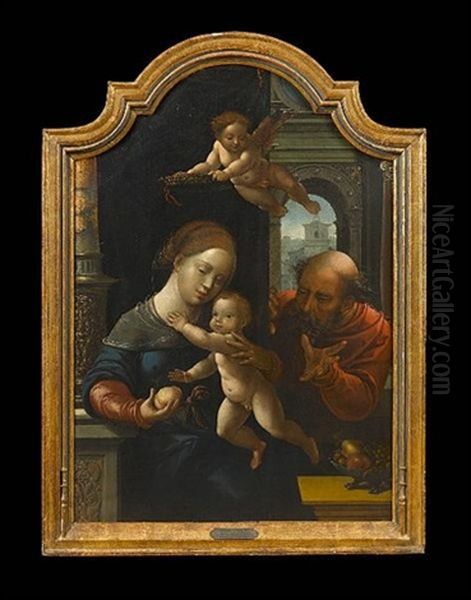
Van Orley's talent quickly gained recognition. A significant milestone in his career occurred around 1515 when he entered the service of Margaret of Austria, the Habsburg Regent of the Netherlands. By 1518, he was officially appointed as her court painter, a prestigious position that provided him with financial stability, access to elite circles, and numerous high-profile commissions. This appointment solidified his status as a leading artist in Brussels.
His connection to the Habsburg court continued after Margaret's death in 1530. He went on to serve her successor, Mary of Hungary, sister of Holy Roman Emperor Charles V. Working for the most powerful patrons in the region allowed Van Orley to operate a large and highly productive workshop. This workshop employed numerous assistants and apprentices, enabling the execution of large-scale projects, particularly the complex tapestry cartoons for which he became famous. His role extended beyond mere production; he also served as an art advisor to the Brussels city council, influencing the artistic direction of the city.
Artistic Style: The Fusion of North and South
Bernaert van Orley is perhaps best known for his role in developing and popularizing the "Romanist" style in the North. This term refers to Northern European artists who assimilated stylistic elements from the Italian Renaissance, particularly the art of Rome and Florence, often after travelling to Italy or, as is debated in Van Orley's case, through exposure to Italian art via prints, drawings, and other intermediaries.
A key point of discussion among art historians is whether Van Orley ever travelled to Italy. While his work demonstrates a clear and sophisticated understanding of Italian High Renaissance principles, particularly those of Raphael, there is no documentary evidence confirming such a journey. It is highly probable that he absorbed these influences through the circulation of prints, especially those by Marcantonio Raimondi reproducing Raphael's designs, and possibly through direct contact with Italian artworks or cartoons present in Brussels, perhaps within the court collections. The influence of Leonardo da Vinci can also be discerned in some works, particularly in the subtle modeling and psychological depth of figures.
Regardless of the means, the Italian influence is undeniable. Van Orley adopted the monumental figure types, dynamic compositions, classical architectural settings, and graceful poses characteristic of Raphael and his circle. He moved away from the more static and angular forms of the earlier Flemish tradition towards a greater sense of movement, volume, and idealized beauty. His compositions often feature complex spatial arrangements and a clear narrative structure, reflecting High Renaissance ideals.
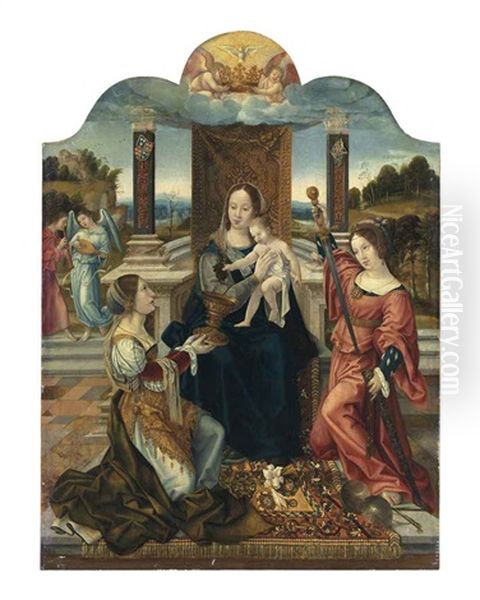
However, Van Orley did not simply imitate Italian models. He skillfully fused these new elements with his native Netherlandish artistic heritage. He retained the Northern penchant for meticulous detail, the rendering of rich textures (silks, velvets, furs, jewels), the use of vibrant and luminous colors, and often incorporated detailed landscape backgrounds. His figures, while idealized, frequently possess a Northern specificity and emotional directness. This synthesis created a unique style that was both innovative and deeply rooted in his local context. The influence of contemporary German master Albrecht Dürer, whom Van Orley met, is also sometimes noted, particularly in graphic precision and expressive power.
Major Works: Painting
Van Orley's painted oeuvre includes altarpieces, devotional panels, and portraits. Among his most celebrated works is the Triptych of the Virtue of Patience, also known as the Job Altarpiece, created around 1521 and now housed in the Royal Museums of Fine Arts of Belgium in Brussels. This complex work, commissioned by Margaret of Austria in memory of her deceased husband, Philibert II of Savoy, depicts the trials of Job alongside related biblical scenes, showcasing Van Orley's ability to handle intricate narratives, dynamic figure groups, and rich detail within an Italianate framework.
Another significant early work is the Altarpiece of Saints Thomas and Matthew, commissioned by the Brussels Guild of Masons and Carpenters around 1512-1515 for the Notre-Dame du Sablon church (also now in the Brussels museum). This piece already shows his move towards Renaissance forms, though still retaining some Gothic echoes. It demonstrates his skill in organizing multi-figure compositions and depicting lively narrative scenes from the lives of the apostles.
His devotional paintings often feature the Holy Family or the Virgin and Child. Works like The Holy Family (c. 1510-1520, various versions exist) and Virgin and Child with Angels (c. 1518, Metropolitan Museum of Art, New York) display a tenderness and grace influenced by Raphael, combined with Flemish precision in rendering details and landscape settings. Rest on the Flight into Egypt (Louvre, Paris) is another notable example, though its attribution has sometimes been debated, with suggestions pointing towards workshop collaboration or even another artist like Jan Coninxloo.
Van Orley also produced numerous portraits for the Habsburg court and other wealthy patrons. He painted portraits of Charles V, Margaret of Austria, and Mary of Hungary, among others. These portraits, while often formal according to courtly conventions, reveal his ability to capture a likeness and convey a sense of the sitter's status and personality, often employing the rich detail and refined finish characteristic of his style. Works like Portrait of Margaret of Austria or Portrait of Charles V exemplify his contribution to court portraiture.
Master of Tapestry Design
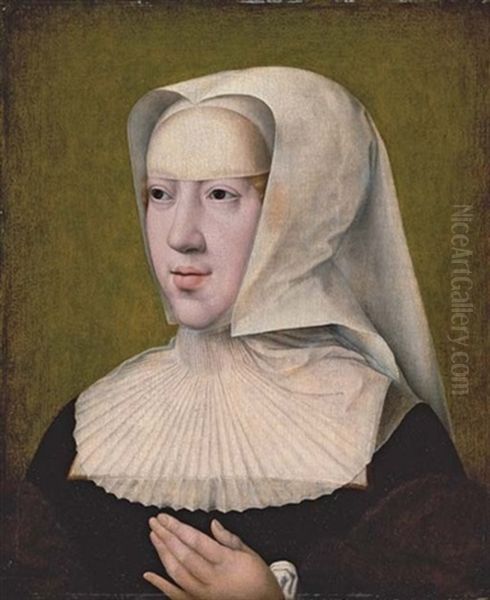
While a significant painter, Bernaert van Orley's impact on the art of tapestry design was arguably even more profound and revolutionary. Brussels was the leading center for luxury tapestry production in Europe during the 16th century, and Van Orley played a crucial role in transforming the medium. He moved tapestry design away from the flatter, more decorative, and densely patterned style of the late Gothic period towards large-scale, dynamic, and pictorial compositions that rivaled monumental painting.
He designed numerous prestigious tapestry series, often collaborating with the leading Brussels weaving workshops, such as that of Pieter de Pannemaker. His designs, known as cartoons (full-scale preparatory drawings or paintings), introduced Renaissance principles of composition, perspective, and figural representation to tapestry. He treated the woven surface almost like a fresco, creating illusions of depth and populating his scenes with active, classically-inspired figures set within elaborate architectural or landscape settings.
Among his most famous tapestry designs are The Hunts of Maximilian (c. 1528-1533, Louvre, Paris), a series depicting the hunting activities of the court throughout the months of the year, set in the landscape around Brussels. These tapestries are celebrated for their lively detail, naturalism, and sophisticated composition. Another landmark series is The Battle of Pavia (c. 1528-1531, Museo di Capodimonte, Naples), commemorating Emperor Charles V's victory over the French king Francis I. This series is remarkable for its dramatic intensity, complex battle scenes, and historical accuracy.
Other significant tapestry series designed by Van Orley include The Story of Jacob, The Story of Abraham, and designs based on the Apocalypse. A series depicting The Last Supper, possibly commissioned for the Duke of Alba, further showcases his ability to translate religious narratives into grand, woven spectacles, heavily influenced by Italian models like Leonardo da Vinci's famous fresco, but adapted to the tapestry medium and his own stylistic preferences. His innovations greatly elevated the status of tapestry and influenced designers for generations, including contemporaries like Pieter Coecke van Aelst.
Stained Glass and Other Media
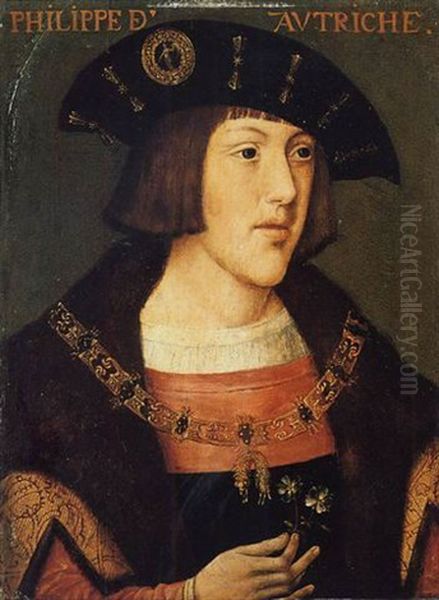
Beyond painting and tapestry, Van Orley was also active as a designer of stained glass. He created designs for significant windows in major churches, most notably the Cathedral of St. Michael and St. Gudula in Brussels. His designs for the large transept windows, featuring portraits of Emperor Charles V, his wife Isabella of Portugal, his sister Mary of Hungary, and her husband Louis II of Hungary, kneeling before holy figures, are prime examples of Renaissance stained glass. These windows combine monumental portraiture with religious iconography, executed with the same blend of Northern detail and Italianate grandeur found in his other works. References also exist to designs related to the wives of Henry VIII, possibly intended for glass or another medium, highlighting the international reach of his reputation.
Workshop and Influence
The scale of Van Orley's production, particularly in tapestry and stained glass design, necessitates the existence of a large and well-organized workshop. He employed numerous assistants and pupils who helped translate his initial sketches into finished cartoons and paintings. This collaborative environment was typical of successful Renaissance workshops.
While a comprehensive list of his pupils is lacking, his most significant follower was undoubtedly Michiel Coxcie (1499–1592). Coxcie worked with Van Orley and later travelled to Italy himself, becoming a prominent Romanist painter often dubbed the "Flemish Raphael." Coxcie's style clearly shows the influence of his master's synthesis of Italian and Northern elements. Other artists associated with his circle or possibly trained in his workshop include Pieter de Kempeneer (Pedro Campaña) and potentially, though less certainly, Marcus Gheeraerts the Elder early in his career. The workshop played a crucial role in disseminating Van Orley's style and working methods throughout the Low Countries.
Contemporaries and Connections
Bernaert van Orley operated within a dynamic network of artists and patrons. His court appointments placed him at the center of Habsburg cultural life in Brussels. His documented meeting and friendship with the renowned German artist Albrecht Dürer during Dürer's visit to the Netherlands in 1520-1521 is significant. Dürer drew a portrait of Van Orley and praised him in his journal, indicating mutual respect between these two leading Northern artists.
He was also closely associated with Jan Gossaert (c. 1478–1532), often called Mabuse, another key pioneer of Romanism in the Low Countries, active slightly earlier than Van Orley. While their styles differ, they shared an interest in Italian models and likely influenced each other. Other important Netherlandish contemporaries included the Antwerp masters Quentin Matsys and Joos van Cleve, and the Leiden painter and printmaker Lucas van Leyden, whose works contributed to the complex artistic landscape Van Orley navigated. His work shows an awareness of these various trends, even as he forged his own distinct path.
Art Historical Debates and Attributions
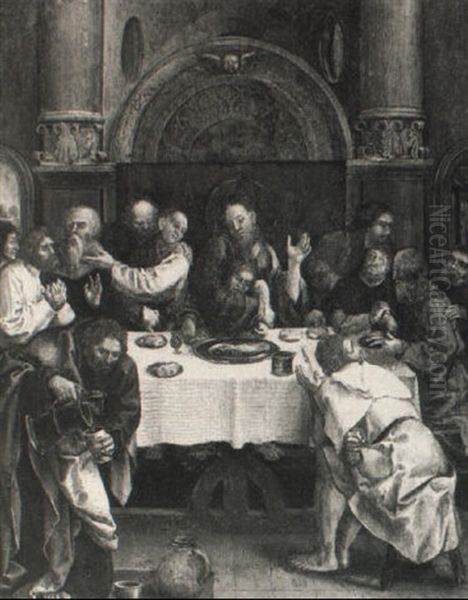
Several aspects of Van Orley's life and work remain subjects of art historical discussion. The question of his potential trip to Italy continues to be debated, though the consensus leans towards him absorbing Italian influence indirectly. The precise nature of his stylistic synthesis – how successfully he balanced Northern and Southern elements – is also analyzed, with some critics seeing a tension or occasional awkwardness, while most praise his innovative fusion.
Attribution remains a challenge, particularly given the collaborative nature of his large workshop. Distinguishing between works by the master's own hand, those executed by assistants under his supervision, and works merely in his style can be difficult. The example of the Rest on the Flight into Egypt highlights this issue, where attributions have shifted over time. Ongoing research continues to refine our understanding of his oeuvre and the contributions of his workshop collaborators.
Later Life and Legacy
Bernaert van Orley remained a dominant figure in the Brussels art scene until his death in 1541. He was buried in the Church of St. Géry in Brussels. He left behind a substantial body of work across multiple media and a significant artistic legacy. He was instrumental in establishing the Romanist style in the North, paving the way for the next generation of Flemish artists who would more fully embrace Italianate forms, such as Frans Floris and Marten de Vos.
His greatest impact arguably lies in tapestry design, where his innovations transformed the medium into a form capable of conveying complex narratives with the monumentality and dynamism of High Renaissance painting. His work set a standard for Brussels tapestry that maintained the city's preeminence for decades. He successfully managed a large enterprise, navigated the demands of elite patronage, and created a distinctive artistic identity by bridging two powerful artistic traditions.
Conclusion
Bernaert van Orley emerges from the historical record as a highly accomplished, versatile, and influential artist of the Northern Renaissance. As a painter, tapestry designer, and stained glass artist, he demonstrated exceptional skill and ambition. His role as court painter to the Habsburg regents placed him at the pinnacle of artistic life in the Low Countries. By thoughtfully integrating the lessons of the Italian Renaissance with the rich heritage of Flemish art, he forged a powerful and enduring style. His work not only reflects the artistic currents of his time but also actively shaped the future direction of art in Northern Europe, leaving a legacy that confirms his status as a true master of his era.